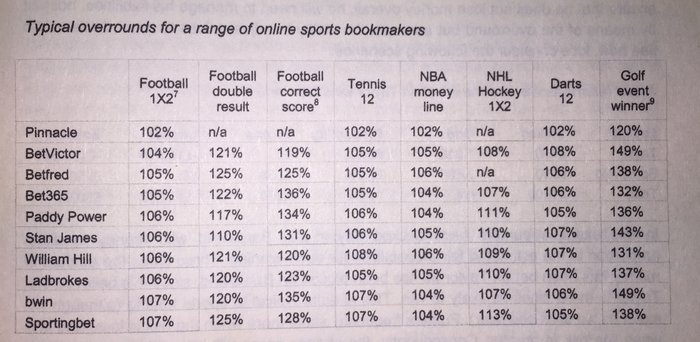The Bookmaker’s profit margin or “overround”

In Anglosaxon terminology the “over round” refers to the profit margin that the bookmaker applies when making a market for their betting customers. The overround is the sum of the inverse of the odds:
Overround = (1/Odds1 + 1/Odds2 +…+ 1/Oddsn)
Let’s look at an example. Let’s imagine a Real Madrid v Barcelona fixture in which the bookmaker prices up the game with the following “a priori” probabilities: Read Madrid: 45%, Draw: 25%, Barcelona: 30%. In the absence of profit margins, these probabilities converted to odds would be (1/probability): Real Madrid: 2.22, Draw: 4.0, Barcelona: 3.33. To make money the bookmaker needs to offer lower prices than these, for example: Real Madrid: 2.10, Draw: 3.70, Barcelona: 3.20. The new probability associated with each price is now: 47.6% for Real Madrid, 27.0% for the draw and 31.3% for the Barcelona victory. The overround is calculated by adding these probabilities, which in this case sums to 1.059 or +105.9%.

The bookmaker’s overround will always be greater than 100%. The higher it is, the higher the bookmaker’s profit margin and the more difficult it is for the punter to make money. The overround the bookmaker applies depends on various factors:
1. The Sport. The degree of competition is very influential. Football is the most competitive sport there is, so bookmakers have to offer good odds in order to attract bettors, leading to a reduction in their profit margins. On the other hand, sports in which less information is freely available or where the result depends on only one or two players (possibility of match-fixing) introduces more uncertainty and therefore leads to less generous odds being offered.
2. The number of possible outcomes. The higher the number of possible outcomes, the greater the uncertainty, so the house protects itself by offering lower prices. When this occurs, the risk to the house normally increases the higher the odds are. In addition, a greater number of outcomes also makes it harder for the bookie to balance their books. For example betting on horse racing or on the winner of a golf tournament the overround will generally be larger than that of a football match with just 3 outcomes.
3. The bookmaker’s strategy. Just like in any other industry, every bookmaker has its own strategy. Some will decide to put all their efforts into marketing and offer very poor odds, while others will prefer to offer a better service with more competitive odds.
Below is a table produced by Joseph Buchdahl (member of Pyckio) in his book “How to find a black cat in a coal cellar, the truth about sports tipsters”, in which the average overrounds from a range of English bookmakers are presented. We can see a big difference, both by sport as well as by bookmaker. Football (in the Premier League 1X2 market) is the sport in which profit margins are the smallest. Next follow NBA and tennis. For less popular leagues, the figure will be larger. If we move to the correct score football market or market for golf tournament winner, we will find huge overrounds. Conclusion: don’t bet on markets with very high overrounds like correct score because in the long-term the probability you have of winning will approach zero.

Another way of expressing the overround, which some odds comparison sites show, is the Payout Ratio. Payout Ratio = 1/Overround. In our example the payout ratio is 1/1.059 = 94.4%, also expressed as a profit margin of 5.6% for the house. The payout ratio represents the percentage of capital that the bettor is likely to receive back from the bookmakers, assuming the bookmaker’s book is totally balanced.
As a final piece of advice we recommend that you don’t bet with bookmakers that have very high overrounds. You might be capable of estimating the probabilities better than the market (even if subconsciously), but it is difficult to defeat high profit margins in the long term.To be able to defeat the overround the best thing to do is have accounts with a wide range of betting houses. For example, if you are going to bet 1X2 on a football game and you have the option of placing the bet with 5 different bookmakers, by choosing the house with the best odds for the Home win, or Draw or Away win, you are “manufacturing” a smaller overround than you would if you only bet with one bookmaker.



Interesante, y siempre mi preferida a la cabeza Pinnacle con payouts de 98% normalmente. Pero quisiera calcular el Overround de las casas de apuestas europeas en el Beisbol que es donde más experto soy, aunque de seguro Pinnacle estará a la cabeza por cuotas a simple vista y por experiencia.
Artículos como este hacen falta.
Gracias tocayo por este tipo de artículos.
Un saludo,
Daniel
En mi blog podeis ver un ejemplo con Visual Basic 6 donde se explica la transformación de cuotas a porcentajes.
http://www.manejandodatos.es/2013/8/ejemplo-de-programacion-en-vb6/